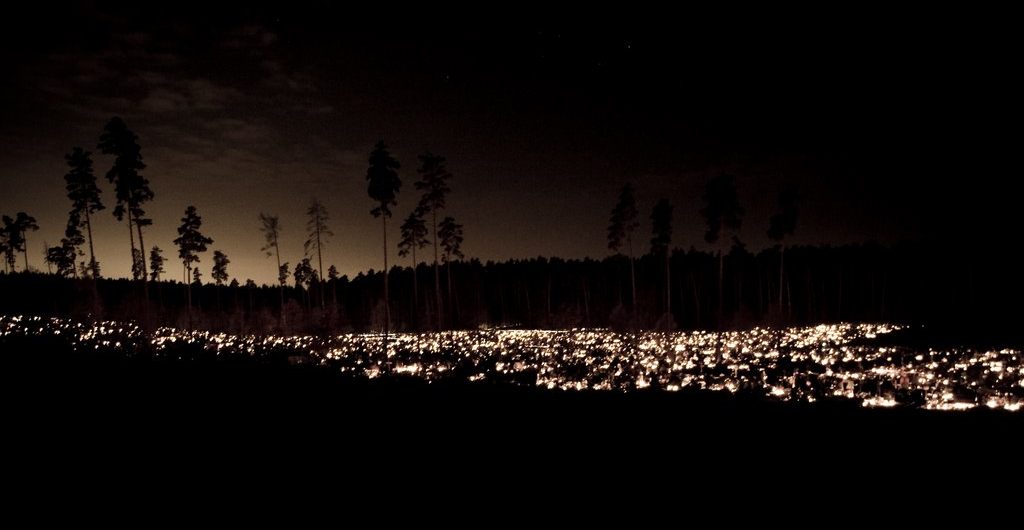Day of the Dead in Lithuania (Vėlinės): Where Pagan and Christian Traditions Meet in Enchanting Cemetery Settings.
Vilnius in Love, a tour company specializing in unique and personalized excursions across Lithuania, invites to special tours of unique cemeteries, autumn countryside, and the Hill of Crosses.
October 23, 2017 – Vilnius, Lithuania. On the first day of November, Lithuanian offices, shops and schools close, roads become packed with cars, families reunite, and everyone heads to one special place – the cemetery.
Lithuanian cemeteries are already different from what you’d find in other countries – they rather resemble a botanical park, sinking in the sea of trees, adorned with flowers and beautiful tombstones. On November 1st, Lithuanians celebrate Vėlinės (vėlė means “soul” and ilgėtis means “to long”) – the Day of the Dead, which is not as joyful an occasion as El Dia de Los Muertos in Mexico, but rather the day of remembrance and reunion that bears deep traditions. Cemeteries become the place of family gatherings, where young and old arrange flowers and light candles. When the sun sets, the cemeteries become enchanting, alive and mysterious from the sea of flickering candlelights and the aroma of thousands of fresh flowers.
When golden trees and low-hanging sun create special autumn atmosphere, it’s a perfect time to visit Lithuania and to get enchanted by the scenery and traditions, to explore some off-the-beaten track activities, and to see some old Lithuanian customs put into action.
According to the old Lithuanian tradition, this is the time to remember the ancestors and to re-think one’s place in the world. When Lithuania finally accepted Christianity (last country to be “baptised” in Europe), pagan and Christian traditions blended into one over time, giving special significance and depth to the Lithuanian Day of the Dead.
The Old Cemeteries of Vilnius
Did you know that the Old Vilnius Cemeteries belong to the list of European historical cemetery heritage?
There are three main cemeteries in Vilnius city center: the first one, Rasų Cemetery, was founded in 1796, and is the eternal home to famous Lithuanian poets, artists and politicians, such as the activist and folklorist Jonas Basanavicius and composer and painter M.K. Ciurlionis. This was the first cemetery that was founded outside of the city, on a hill surrounded by old oak trees. The name of the place – Rasos – suggests this used to be an ancient pagan ceremony site.
The Bernardine Cemetery was established in 1810 by the Bernardine monks of the the Church of St. Francis of Assisi. As most cemeteries in the city center, it was closed by the Soviets and remained mostly unchanged from that time, with burials allowed only in existing family graves.
Antakalnis Cemetery is commonly o referred to as the Military Cemetery. 12 of the 14 Soviet Union protest victims from 1991 TV tower attack are buried here, as well as the victims of Soviet Medininkai Massacre. Among other perished soldiers there are graves of Polish soldiers from 1919-20, Lithuanian, German and Russian soldiers who have fallen in World War 1 and thousands of French soldiers of Napoleon’s Army, whose remains were found in Vilnius and reburied in Antakalnis in 2001.
During Vėlinės, these old cemeteries are afloat with flowers and sinking in the sea of candles – people come to remember the dead heroes or prominent poets of the nation, but they also don’t forget the unknown graves of dead people whose relatives might not around anymore to light a candle.
Lithuanian Cross-Making and the Hill of Crosses
If you feel like venturing outside of Vilnius, Southern Lithuanian region of Dzukija and Lithuanian seaside will offer a very special glimpse into the culture of Lithuanian cemeteries, with their unique crosses and breathtaking nature that surrounds them.
The Lithuanian art of cross-making was recognized to be unique and added to the UNESCO World Heritage list. Since Lithuania was the last country of Europe to abandon paganism and convert to Catholicism in the 14th century, pagan and Catholic elements intertwine in Lithuanian crosses – which were forbidden by Tsarist Russia and the Soviet Union.
Lithuania’s Hill of Crosses, located in the northern Lithuania, is a unique and enchanting place, featuring over 100,000 of crosses of every shape and size, and attracting thousands of Catholic pilgrims as well as curious tourists looking for unique experiences.
Pre-Christian Cemeteries
At the same time, you can find cemeteries in Lithuania that have no crosses – these are pre-Christian pilkapiai dating from 12-13th century, and abandoned in the 14th century, reminding everyone of pagan Lithuania. The most prominent site of pilkapiai is in Kernave, whose first residents arrived in the 9th century BC, and which later became an important city of pagan Lithuania.
Similarly, you wouldn’t find any crosses in the ethnic Jewish cemeteries, or the cemeteries of Lithuanian Turkic minorities – Tatars and Karaites.
Lithuanian Cemetery Excursions:
- Royal Mausoleum. A visit to the crypts of Vilnius Cathedral
- Uzupis neighborhood. The Bernardine Cemetery
- The old Military Cemetery of Antakalnis
- Rasu Cemetery
- The pagan capital Kernave and pilkapiai
- The Hill of Crosses in Northern Lithuania
- National Park of Dzukija
- National Park of Curonian Spit
- Jewish Vilnius
- Trakai Castle and old Karaites cemetery
Visiting Lithuania would certainly be a unique experience, and a number of excursions can also integrate visits to other local attractions. To find out more about touristic or heritage tours in Lithuania, please visit Vilnius in Love.
ABOUT VILNIUS IN LOVE
Vilnius in Love is an exclusive tour guide company that offers customizable and personalized tours across all regions of Lithuania. Hiring guides who are very well versed in local history, they are able to offer trips to unique destinations and rare attractions. Contact: Visit VilniusinLove.com to learn more. For press inquiries, contact: kristina@utterbuzzpr.com.


Comments